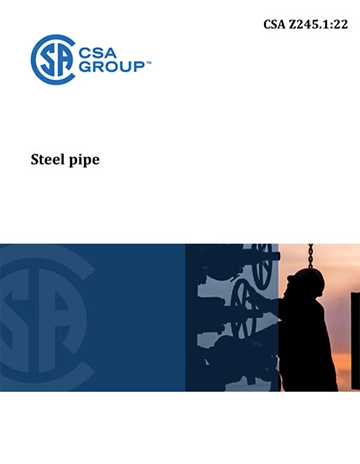Thanks to the financial contribution of the Western Regulators Forum (WRF), CSA Group is providing the CSA Petroleum and Natural Gas standards in a downloadable PDF format for no fee to Canadian customers only (Click for more detail). If you are not in Canada, please reach out to one of the following licensed CSA Group resellers to purchase these standards or contact your local reseller:
• Accuris (formerly S&P Global) (https://global.ihs.com/)
• Techstreet (https://www.techstreet.com/)
Preface
This is the eleventh edition of CSA Z245.1, Steel pipe. It supersedes the previous editions published in 2018, 2014, 2007, 2002, 1998, 1995, 1993, 1990, 1986, and 1982.
This Standard covers the requirements for steel pipe intended to be used for transporting fluids as specified in CSA Z662.
The main changes to this edition are the following:
a) updated optional product ordering requirements (Clause 4.1.2);
b) revised requirements for product analysis retests (Clause 6.3.5);
c) revised requirements for Charpy V-notch impact tests (Clause 7.6, Table 7, Figure 4, and Annex C);
d) revised weld notch-toughness test requirements for electric-welded pipe (Clause 8.5.2);
e) updated requirements for visual inspection of defects (Clause 11.6.1);
f) updated required markings (Clauses 15.2and 15.4);
g) updated purchase order requirements for elevated temperature service pipe (Clause 17.2);
h) new requirements for pipe for strain-based design (Clauses 18and 19.7);
i) new hydrostatic test pressure reporting requirements (Clause 19.10); and
j) new requirements for records (Clause 19.11).
This Standard was prepared by the Subcommittee on Materials, under the jurisdiction of the Technical Committee on Petroleum and Natural Gas Industry Pipeline Systems and Materials and the Strategic Steering Committee on Petroleum and Natural Gas Industry Systems, and has been formally approved by the Technical Committee.
Scope
1.1 General
This Standard covers seamless pipe, electric-welded pipe (flash-welded pipe continuously welded and low-frequency electric-welded pipe excluded), and submerged-arc-welded pipe primarily intended for use in oil or gas pipeline systems.
Notes:
1) Flash-welded pipe is pipe manufactured by a process using electric-resistance heating to produce a simultaneous coalescence over the entire area of the abutting edges and the application of pressure for joining.
2) Low frequency is less than 70 kHz.
1.2 Outside diameter, grade, and category
Note: It is not intended that pipe be available in all combinations of size, grade, category, and manufacturing process. The individual pipe manufacturers should be consulted to ascertain the availability of specific pipe items.
1.2.1 Outside diameter
This Standard covers pipe having specified outside diameters (ODs) from 21.3 to 2032 mm. The standard ODs are given in Table B.1.
1.2.2 Grade
For other than sour service, this Standard covers pipe from Grade 241 to Grade 825. For sour service, this Standard covers pipe from Grade 241 to Grade 483.
Note: The standard grades are Grades 241, 290, 359, 386, 414, 448, 483, 550, 620, 690, and 825; however, intermediate grades may also be used.
1.2.3 Category
This Standard covers pipe in the following categories:
a) Category I: pipe without requirements for proven pipe body notch-toughness properties;
b) Category II: pipe with requirements for proven pipe body notch-toughness properties in the form of energy absorption and fracture appearance; and
c) Category III: pipe with requirements for proven pipe body notch-toughness properties in the form of energy absorption.
1.3 Terminology
In this Standard, shall is used to express a requirement, i.e., a provision that the user is obliged to satisfy in order to comply with the Standard; should is used to express a recommendation or that which is advised but not required; and may is used to express an option or that which is permissible within the limits of the Standard.
Notes accompanying clauses do not include requirements or alternative requirements; the purpose of a note accompanying a clause is to separate from the text explanatory or informative material.
Notes to tables and figures are considered part of the table or figure and may be written as requirements.
Annexes are designated normative (mandatory) or informative (non-mandatory) to define their application.


